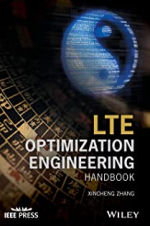LTE Optimization Engineering Handbook by Xincheng Zhang, ISBN-13: 978-1119158974
[PDF eBook eTextbook]
- Publisher: Wiley-IEEE Press; 1st edition (January 4, 2018)
- Language: English
- 840 pages
- ISBN-10: 1119158974
- ISBN-13: 978-1119158974
A comprehensive resource containing the operating principles and key insights of LTE networks performance optimization.
LTE Optimization Engineering Handbook is a comprehensive reference that describes the most current technologies and optimization principles for LTE networks. The text offers an introduction to the basics of LTE architecture, services and technologies and includes details on the key principles and methods of LTE optimization and its parameters. In addition, the author clarifies different optimization aspects such as wireless channel optimization, data optimization, CSFB, VoLTE, and video optimization.
With the ubiquitous usage and increased development of mobile networks and smart devices, LTE is the 4G network that will be the only mainstream technology in the current mobile communication system and in the near future. Designed for use by researchers, engineers and operators working in the field of mobile communications and written by a noted engineer and experienced researcher, the LTE Optimization Engineering Handbook provides an essential guide that:
- Discusses the latest optimization engineering technologies of LTE networks and explores their implementation
- Features the latest and most industrially relevant applications, such as VoLTE and HetNets
- Includes a wealth of detailed scenarios and optimization real-world case studies
Professionals in the field will find the LTE Optimization Engineering Handbook to be their go-to reference that includes a thorough and complete examination of LTE networks, their operating principles, and the most current information to performance optimization.
Table of Contents:
About the Author xvi
Preface xvii
Part 1 LTE Basics and Optimization Overview 1
1 LTE Basement 3
1.1 LTE Principle 3
1.1.1 LTE Architecture 6
1.1.2 LTE Network Interfaces 7
1.2 LTE Services 11
1.2.1 CircuitSwitched Fallback 12
1.2.2 Voice over LTE 13
1.2.3 IMS Centralized Services 16
1.2.4 Over the Top Solutions 16
1.2.5 SMS Alternatives over LTE 17
1.2.6 Converged Communication 19
1.3 LTE Key Technology Overview 19
1.3.1 Orthogonal Frequency Division Multiplexing 20
1.3.2 MIMO 21
1.3.3 Radio Resource Management 22
2 LTE Optimization Principle and Method 24
2.1 LTE
Wireless Optimization Overview 24
2.1.1 Why LTE Wireless Optimization 24
2.1.2 Characters of LTE Optimization 24
2.1.3 LTE Joint Optimization with 2G/3G 25
2.1.4 Optimization Target 25
2.2 LTE Optimization Procedure 26
2.2.1 Optimization Procedure Overview 26
2.2.2 Collection of Mass Nerwork Measurement Data 28
2.2.3 Measurement Report Data Analysis 30
2.2.4 Signaling Data Analysis 31
2.2.5 UE Positioning 32
2.2.5.1 Timing Advance 33
2.2.5.2 Location Accuracy Evaluation 35
2.2.5.3 Location Support 36
2.2.5.4 3D Geolocation 37
2.2.6 Key Performance Indicators Optimization 42
2.2.7 Technology Evolution of Optimization 43
2.3 LTE Optimization Key Point 44
2.3.1 RF Optimization 44
2.3.1.1 RSRP/RSSI/SINR/CINR 44
2.3.1.2 External Interference 48
2.3.2 CQI versus RSRP and SINR 51
2.3.2.1 CQI Adjustment 51
2.3.2.2 SINR Versus Load 54
2.3.2.3 SINR Versus MCS 56
2.3.3 Channel Power Configuration 58
2.3.3.1 RE Power 58
2.3.3.2 CRS Power Boosting 64
2.3.3.3 Power Allocation Optimization 66
2.3.4 Link Adaption 67
2.3.5 Adaptive Modulation and Coding 69
2.3.6 Scheduler 70
2.3.6.1 Downlink Scheduler 72
2.3.6.2 Uplink Scheduler 74
2.3.7 Radio Frame 75
2.3.8 System Information and Timers 76
2.3.8.1 System Information 76
2.3.8.2 Timers 81
2.3.9 Random Access 83
2.3.10 Radio Admission Control 85
2.3.11 Paging Control 86
2.3.11.1 Paging 86
2.3.11.2 Paging Capacity 92
2.3.11.3 Paging Message Size 95
2.3.11.4 Smart Paging 95
2.3.11.5 Priority Paging 96
2.3.12 MIMO and Beamforming 97
2.3.12.1 Basic MultiAntenna Techniques 100
2.3.12.2 2DBeamforming 101
2.3.12.3 2D MIMO and Parameters 104
2.3.12.4 MassiveMIMO 105
2.3.13 Power Control 107
2.3.13.1 PUSCH/PUCCH Power Control 107
2.3.13.2 PRACH Power Control 109
2.3.14 Antenna Adjustment 111
2.3.14.1 Antenna Position 112
2.3.14.2 Remote Electrical Tilt 113
2.3.14.3 Antenna Azimuths and Tilts Optimization 117
2.3.14.4 VSWR Troubleshooting 118
2.3.15 Main Key Performance Indicators 120
Part 2 Main Principles of LTE Optimization 123
3 Coverage Optimization 125
3.1 Traffic Channel Coverage 125
3.1.1 Parameters of Coverage 126
3.1.2 Weak Coverage 128
3.1.2.1 DL Coverage Hole 128
3.1.2.2 UL Weak Coverage 128
3.1.2.3 UL and DL Imbalance 129
3.1.3 Overlapping Coverage 129
3.1.4 Overshooting 130
3.1.5 Tx1/Tx2 RSRP Imbalance 132
3.1.6 Extended Coverage 132
3.1.7 Cell Border Adjustment 135
3.1.8 Vertical Coverage 137
3.1.9 Parameters Impacting Coverage 138
3.2 Control
Channel Coverage 138
4 Capacity Optimization 140
4.1 RS SINR 140
4.2 PDCCH
Capacity 141
4.3 PUCCH Capacity 144
4.3.1 Factors Affecting PUCCH Capacity 145
4.3.2 PUCCH Dimensioning Example 151
4.4 Number of Scheduled UEs 152
4.5 Spectral Efficiency 153
4.6 DL
Data Rate Optimization 154
4.6.1 Limitation Factor 156
4.6.2 Model of DL Data Throughput 157
4.6.3 UDP/TCP Protocol 158
4.6.4 MIMO 161
4.6.4.1 DL MIMO 161
4.6.4.2 4Tx/4Rx Performance 163
4.6.4.3 Transmission Mode Switch 163
4.6.4.4 UL MUMIMO 164
4.6.5 DL PRB Allocation and Utilization Mechanism 165
4.6.6 DL BLER 167
4.6.7 Impact of UE Velocity 169
4.6.8 Single User Throughput Optimization 170
4.6.8.1 Radio Analysis – Assignable Bits 171
4.6.8.2 Radio Analysis – CFI and Scheduling 171
4.6.8.3 Radio Analysis – HARQ 171
4.6.9 Avarage Cell Throughput Optimization 172
4.6.10 Cell Edge Throughput Optimization 172
4.6.11 Some Issues of DL Throughput 173
4.6.11.1 Antenna Diversity not Balanced 173
4.6.11.2 DL Grant is not Enough 173
4.6.11.3 Unstable Rate 175
4.7 UL Data Rate Optimization 175
4.7.1 Model of UL Data Throughput 176
4.7.2 UL SINR and PUSCH Data Rate 176
4.7.3 PRB Stretching and Throughput 179
4.7.4 Single User Throughput Optimization 180
4.7.4.1 Radio Analysis – Available PRBs 181
4.7.4.2 Radio Analysis—Link Adaptation 181
4.7.4.3 Radio Analysis – PDCCH 182
4.7.5 Cell Avarage and Celledge Throughput Optimization 182
4.7.6 Some Issues of UL Throughput 183
4.8 Parameters Impacting Throughput 185
5 Internal Interference Optimization 188
5.1 Interference Concept 188
5.2 DL
Interference 190
5.2.1 DL Interference Ratio 191
5.2.2 Balance Between SINR and RSRP 192
5.3 UL Interference 192
5.3.1 UL Interference Detection 194
5.3.2 Generation of UL Interference 196
5.3.2.1 Cell Loading Versus InterCell Interference 196
5.3.2.2 Unreasonable UL Network Structure 197
5.3.2.3 Cross slot interference 199
5.3.3 PUSCH Tx Power Analysis 200
5.3.4 UL Effect of P0 and α 202
5.3.5 PRACH Power Control 204
5.3.6 SRS Power Control 206
5.3.7 Interference Rejection Combinin 209
5.4 InterCell Interference Coordination 210
5.5 UL IoT Control 210
5.5.1 UL Interference Issues and Possible Solutions 210
5.5.2 UL IoT Control Mechanism 210
5.5.3 PUSCH UL_SINR Target Calculation 212
5.5.4 UL Interference Criteria 213
6 Drop Call Optimization 216
6.1 Drop Call Mechanism 216
6.1.1 Radio Link Failure Detection by UE 217
6.1.2 RadioLink Failure Detection by eNB 220
6.1.2.1 Link Monitors in eNB 220
6.1.2.2 Time Alignment Mechanism 221
6.1.2.3 Maximum RLC Retransmissions Exceeded 224
6.1.3 RadioLink Failure Optimization and Recovery 225
6.2 Reasons of Call Drop and Optimization 227
6.2.1 Reasons of ERAB Drop 227
6.2.2 S1 Release 230
6.2.3 Retainability Optimization 233
6.3 RRC Connection Reestablishment 233
6.4 RRC Connection Supervision 239
7 Latency Optimization 244
7.1 User Plane Latency 244
7.2 Control Plane Latency 247
7.3 Random Access Latency Optimization 247
7.4 Attach Latency Optimization 248
7.5 Paging Latency Optimization 250
7.6 Parameters Impacting Latency 250
8 Mobility Optimization 254
8.1 Mobility Management 255
8.1.1 RRC Connection Management 256
8.1.2 Measurement and Handover Events 256
8.1.3 Handover Procedure 260
8.1.3.1 X2 Handover 261
8.1.3.2 S1 Handover 267
8.1.3.3 Key point of X2/S1 Handover 267
8.2 Mobility Parameter 269
8.2.1 Attach and Dettach 272
8.2.2 UE Measurement Criterion in Idle Mode and Cell Selection 273
8.2.3 Cell Priority 276
8.3 IntraLTE Cell Reselection 276
8.3.1 Cell Reselection Procedure 278
8.3.2 InterFrequency Cell Reselection 279
8.3.3 Cell Reselection Parameters 282
8.3.4 InterFrequency Reselection Optimization 283
8.4 IntraLTE Handover Optimization 285
8.4.1 A3 and A5 Handover 285
8.4.2 Data Forwarding 290
8.4.3 IntraFrequency Handover Optimization 291
8.4.4 InterFrequency Handover Optimization 292
8.4.5 Timers for Handover Failures 296
8.5 Neighbor Cell Optimization 297
8.5.1 IntraLTE Neighbor Cell Optimization 297
8.5.1.1 Neighbor Relations Table 297
8.5.1.2 ANR 298
8.5.2 Suitable Neighbors for Load Balancing 299
8.6 Measurement Gap 299
8.6.1 Measurement Gap Pattern 299
8.6.2 Measurement Gap Versus Period of CQI Report and DRX 304
8.6.3 Impact of Throughput on Measurement Gap 304
8.7 Indoor and Outdoor Mobility 305
8.8 InterRAT Mobility 306
8.8.1 InterRAT Mobility Architecture and Key Technology 307
8.8.2 LTE to G/U Strategy 309
8.8.3 Reselection Optimization 314
8.8.3.1 LTE to UTRAN 315
8.8.3.2 UTRAN to LTE 319
8.8.4 Redirection Optimization 320
8.8.4.1 LTE to UTRAN 320
8.8.4.2 UTRAN to LTE 322
8.8.5 PS Handover Optimization 322
8.8.5.1 LTE to UTRAN 322
8.8.5.2 UTRAN to LTE 324
8.8.6 Reselection and Redirection Latency 325
8.8.7 Optimization Case Study 326
8.9 Handover Interruption Time Optimization 326
8.9.1 Control Plane and User Plane Latency 329
8.9.2 InterRAT Mobility Latency 332
8.10 Handover Failure and Improvement 332
8.11 Mobility Robustness Optimization 335
8.12 Carrier Aggregation Mobility Optimization 341
8.13 FDDTDD Intermode Mobility Optimization 345
8.14 Load Balance 346
8.14.1 InterFrequency Load Balance 346
8.14.2 InterRAT Load Balance 348
8.14.3 Load Based Idle Mode Mobility 349
8.15 HighSpeed Mobile Optimization 351
8.15.1 HighSpeed Mobile Feature 353
8.15.2 SpeedDependent Cell Reselection 354
8.15.3 PRACH Issues 356
8.15.4 Solution for Air to Ground 358
9 Traffic Model of Smartphone and Optimization 360
9.1 Traffic Model of Smartphone 360
9.1.1 QoS Mechanism 362
9.1.2 Rate Shaping and Traffic Management 366
9.1.3 Traffic Model 371
9.2 SmartphoneBased Optimization 372
9.3 HighTraffic Scenario Optimization 372
9.3.1 Resource Configuration 374
9.3.2 Capacity Monitoring 375
9.3.3 Special Features and Parameters for High Traffic 377
9.3.4 UL Noise Rise 379
9.3.5 Offload Solution and Parameter Settings 379
Part III Voice Optimization of LTE 383
10 Circuit Switched Fallback Optimization 385
10.1 Voice Evolution 385
10.2 CSFB Network Architecture and Configuration 386
10.2.1 CSFB Architecture 386
10.2.2 Combined Register 387
10.2.3 CSFB Call Procedure 392
10.2.3.1 Fallback Options 392
10.2.3.2 RRC Release with Redirection 393
10.2.3.3 CSFB Call Procedure 395
10.2.4 Mismatch Between TA and LA 397
10.3 CSFB Performance Optimization 402
10.3.1 CSFB Optimization 402
10.3.1.1 Main Issues of CSFB 402
10.3.1.2 CSFB Optimization Method 403
10.3.2 CSFB Main KPI 407
10.3.3 Fallback RAT Frequency Configuration Optimization 409
10.3.4 Call Setup Time Latency Optimization 411
10.3.4.1 ESR to Redirection Optimization 416
10.3.4.2 Twice Paging 416
10.3.5 Data Interruption Time 418
10.3.6 Return to LTE After Call Complete 419
10.4 Short Message Over CSFB 422
10.5 Case Study of CSFB Optimization 423
10.5.1 Combined TA/LA Updating Issue 423
10.5.2 MTRF Issue 425
10.5.3 Track Area Update Reject After CSFB 425
10.5.3.1 No EPS Bearer Context Issue 428
10.5.3.2 Implicitly Detach Issue 428
10.5.3.3 MS Identity Issue 428
10.5.4 Pseudo Base Station 428
11 VoLTE Optimization 434
11.1 VoLTE Architecture and Protocol Stack 435
11.1.1 VoLTE Architecture 435
11.1.2 VoLTE Protocol Stack 435
11.1.3 VoLTE Technical Summary 438
11.1.4 VoLTE Capability in UE 439
11.2 VoIP/Video QoS and Features 442
11.2.1 VoIP/Video QoS 442
11.2.2 Voice Codec 444
11.2.3 Video Codec 446
11.2.4 Radio Bearer for VoLTE 449
11.2.5 RLC UM 454
11.2.6 Call Procedure 457
11.2.6.1 LTE Attach and IMS Register 458
11.2.6.2 E2E IMS Flow 458
11.2.6.3 Video Phone Session Handling 462
11.2.7 Multiple Bearers Setup and Release 466
11.2.8 VoLTE Call OnHold/Call Waiting 467
11.2.9 Differentiated Paging Priority 468
11.2.10 Robust Header Compression 470
11.2.10.1 RoHC Feature 470
11.2.10.2 Gain by RoHC 470
11.2.11 IntereNB Uplink CoMP for VoLTE 475
11.3 Semi
Persistent Scheduling and Other Scheduling Methods 477
11.3.1 SPS Scheduling 477
11.3.2 SPS Link Adaptation 478
11.3.3 Delay Based Scheduling 481
11.3.4 Prescheduling 482
11.4 PRB and MCS Selection Mechanism 484
11.4.1 Optimized Segmentation 484
11.4.2 PRB and MCS Selection 485
11.5 VoLTE Capacity 486
11.5.1 Control Channel for VoLTE 487
11.5.2 Performance of Mixed VoIP and Data 488
11.6 VoLTE Coverage 491
11.6.1 VoIP Payload and RoHC 492
11.6.2 RLC Segmentation 492
11.6.3 TTI Bundling 498
11.6.4 TTI Bundling Optimization 502
11.6.5 Coverage Gain with RLC Segmentation and TTI Bundling 507
11.6.6 MCS/TBS/PRB Selection 509
11.6.7 Link Budget 510
11.7 VoLTE Delay 513
11.7.1 Call Setup Delay 516
11.7.1.1 Call Setup Time 516
11.7.1.2 Reasons for Long Call Setup Time 516
11.7.2 Conversation Start Delay 519
11.7.3 RTP Delay 521
11.7.4 Handover Delay and Optimization 525
11.8 IntraLTE Handover and eSRVCC 527
11.8.1 IntraFrequency Handover 527
11.8.2 InterFrequency Handover 528
11.8.3 Single Radio Voice Call Continuity Procedure 529
11.8.4 SRVCC Parameters Optimization 539
11.8.4.1 Handover Parameters 539
11.8.4.2 SRVCC–Related Timer 539
11.8.5 aSRVCC and bSRVCC 543
11.8.6 SRVCC Failure 543
11.8.7 Reducing SRVCC Voice Gap and eSRVCC 545
11.8.7.1 Voice Interruption Time during SRVCC 545
11.8.7.2 eSRVCC 549
11.8.8 Fast Return to LTE 552
11.8.9 Roaming Behavior According to Network Capabilities 555
11.9 Network Quality and Subjective Speech Quality 555
11.9.1 Bearer Latency 558
11.9.2 MoS 561
11.9.2.1 Voice Quality 561
11.9.2.2 Video Quality 570
11.9.3 Jitter 571
11.9.4 Packet Loss 572
11.9.5 One Way Audio 575
11.9.6 PDCP Discard Timer Operation 576
11.10 Optimization 577
11.10.1 Distribution of Main Indicators of Field Test 580
11.10.2 Compression Ratio and GBR Throughput 584
11.10.3 RB Utilization 584
11.10.4 BLER Issue 587
11.10.5 Quality Due to Handover 589
11.10.6 eSRVCC Handover Issues 589
11.10.7 Packet Loss 592
11.10.7.1 Packet Loss due to Poor RF 592
11.10.7.2 Packet Loss due to Massive users 592
11.10.7.3 Packet Loss Due to Insufficient UL grant 592
11.10.7.4 Packet Loss due to Handover 601
11.10.7.5 Packet Loss Due to Network Issue 601
11.10.8 Call Setup Issues 601
11.10.8.1 Missed Pages 602
11.10.8.2 IMS Issues 604
11.10.8.3 Dedicated Bearer Setup Issues 609
11.10.8.4 CSFB Call Issues 612
11.10.8.5 aSRVCC Failure 612
11.10.8.6 RF Issues 612
11.10.8.7 Frequent TFT Updates 617
11.10.8.8 Encryption Issue 618
11.10.9 Call Drop 619
11.10.9.1 Call Drop 619
11.10.9.2 Radio Link Failure 622
11.10.9.3 RTPRTCP Timeout 624
11.10.9.4 RLC/PDCP SN Length Mismatch 626
11.10.9.5 IMS Session Drop 626
11.10.9.6 eNB/MME Initiated Drop 632
11.10.10 Packet Aggregation Level 632
11.10.11 VoIP Padding 633
11.10.12 VoIP Ralated Parameters 635
11.10.13 VideoRelated Optimization 635
11.10.13.1 Video Bit Rate and Frame Rate 637
11.10.13.2 Video MoS and Audio/Video Sync 637
11.10.14 IMS Ralated Timer 637
11.11 UE Battery Consumption Optimization for VoLTE 638
11.11.1 Connected Mode DRX Parameter 643
11.11.2 DRX Optimization 644
11.11.2.1 State Estimation 644
11.11.2.2 DRX Optimization and Parameters 644
11.11.2.3 KPI Impacts with DRX 648
11.11.3 Scheduling Request Periodicity and Disabling of Aperiodic CQI 652
11.12 Comparation with VoLTE and OTT 654
11.12.1 OTT VoIP User Experience 654
11.12.2 OTT VoIP Codec 657
11.12.3 Signaling Load of OTT VoIP 658
Part IV Advanced Optimization of LTE 663
12 PRACH Optimization 665
12.1 Overview 665
12.2 PRACH Configuration Index 669
12.3 RACH Root Sequence 673
12.4 PRACH Cyclic Shift 674
12.4.1 PRACH Cyclic Shift Optimization 674
12.4.2 Rrestricted Set 679
12.5 Prach Frequency Offset 682
12.6 Preamble Collision Probability 683
12.7 Preamble Power 684
12.8 Random Access Issues 687
12.9 RACH Message Optimization 689
12.10 Accessibility Optimization 692
12.10.1 Reasons for Poor Accessibility 692
12.10.2 Accessibility 693
12.10.3 Accessibility Analysis Tree 695
12.10.4 Call and Data Session Setup Optimization 697
12.10.5 RACH Estimation for Different Traffic Profile 698
13 Physical Cell ID Optimization 702
13.1 Overview 702
13.2 PCI Optimization Methodology 703
13.2.1 PCI Group Optimization 705
13.2.2 PCI Code Reuse Distance 705
13.2.3 Mod3/30 Discrepancy Analysis 708
13.2.4 Collision and Confusion 708
13.3 PCI Optimization 709
14 Tracking Areas Optimization 711
14.1 TA Optimization 712
14.1.1 TA Update Procedure 713
14.1.2 TA Optimization and TAU Failure 715
14.2 TA List Optimization 716
14.3 TAU Reject Analysis and Optimization 719
15 Uplink Signal Optimization 721
15.1 Uplink Reference Signal Optimization 721
15.1.1 Coding Scheme of UL RS 722
15.1.2 Correlation of UL Sequence Group 723
15.1.2.1 UL Sequence Group Hopping 725
15.1.2.2 UL Sequence Hopping 726
15.1.2.3 UL Cyclic Shift Hopping 726
15.1.3 UL Sequence Group Optimization 727
15.2 Uplink Sounding Signal Optimization 729
15.2.1 SRS Characters 730
15.2.2 Wideband SRS Coverage 736
15.2.3 Dynamic SRS Adjustment Scheme 736
15.2.4 SRS Selection Dimension and Confliction 737
15.2.5 SRS Conflict and Optimization 739
16 HetNet Optimization 741
16.1 UE Geolocation and Identification of Traffic Hot Spots 741
16.2 Wave Propagation Characteristics for HetNet 745
16.3 New Features in HetNet 746
16.4 Combined Cell Optimization 747
16.5 Cell Range Expansion Offset 748
16.6 HetNet Cell Reselection and Handover Optimization 751
17 QoE Evaluation and Optimization Strategy 752
17.1 QoE Modeling 753
17.2 Data Collecting and Processing 756
17.3 QoEBased Traffic Evaluation 757
17.3.1 Online Video QoE 757
17.3.1.1 Video Quality Monitoring Methods 761
17.3.1.2 RATE Adaptive Video Codecs 763
17.3.1.3 Streaming KPI and QoE 764
17.3.1.4 Video Optimization 766
17.3.2 Voice QoE 769
17.3.3 Data Service QoE 770
17.3.3.1 Web browsing 770
17.3.3.2 Online Gaming 774
17.4 QoE Based Optimization 776
18 SignalingBased Optimization 780
18.1 S1 AP Signaling 780
18.1.1 NAS signaling 782
18.1.2 Inactivity Supervision 783
18.1.3 UE signaling Management 785
18.2 Signaling radio bearers 786
18.3 Signaling Storm 788
18.4 Signaling Troubleshooting Method 788
18.4.1 Attach Failure 788
18.4.2 Service Request Failure 796
18.4.3 S1/X2Based Handover 796
18.4.4 eSRVCC Failure 798
18.4.5 CSFB Failure 800
Appendix 802
Glossary of Acronyms 820
References 823
Index 825
XINCHENG ZHANG is a Professor and Engineer with more than 20 years’ experience in wireless communications and is a technical expert for one of China’s largest telecom companies, China Mobile Group Design Institute Co., Ltd.
What makes us different?
• Instant Download
• Always Competitive Pricing
• 100% Privacy
• FREE Sample Available
• 24-7 LIVE Customer Support









Reviews
There are no reviews yet.